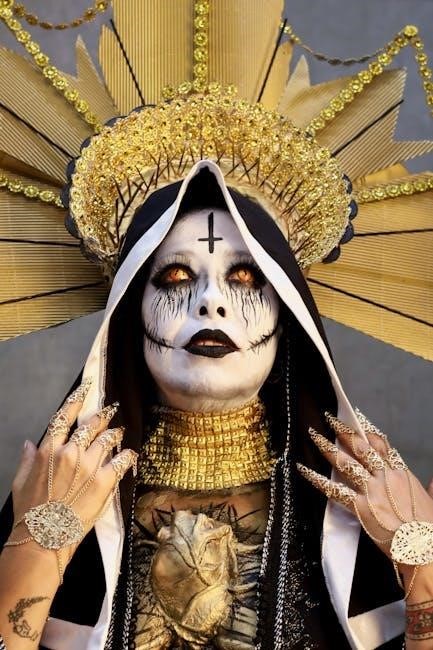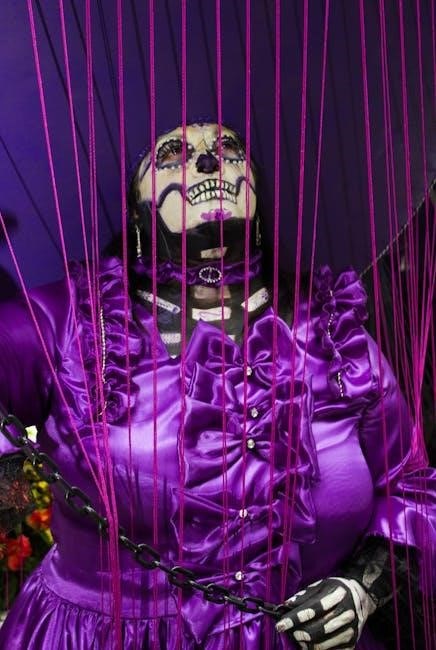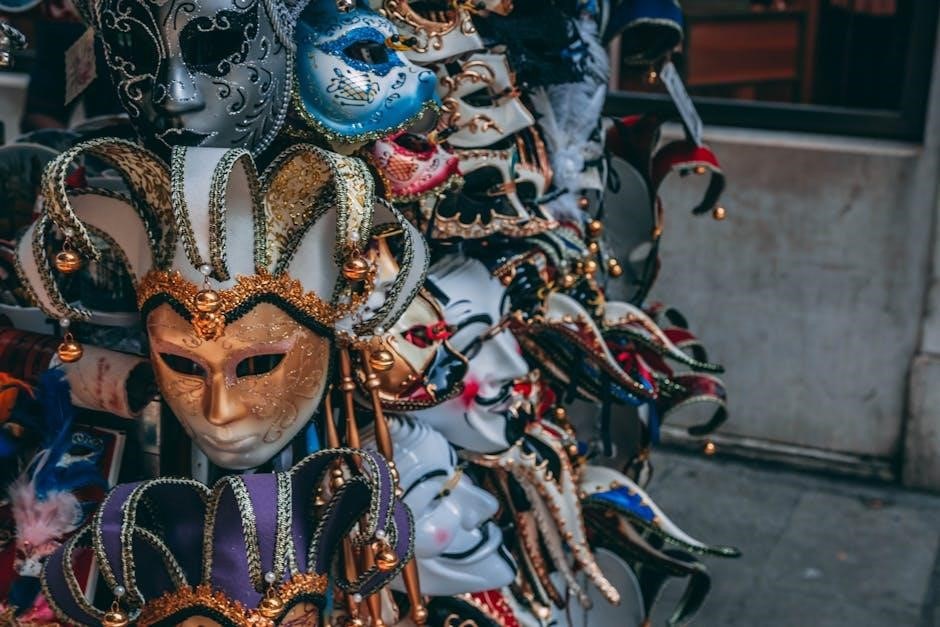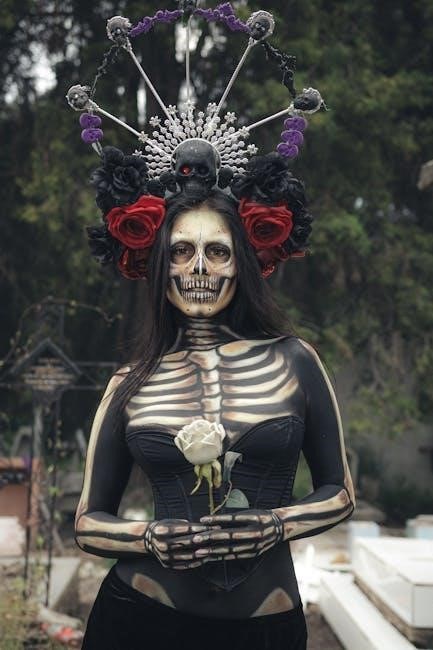1.1 Brief Overview of Vampire: The Masquerade 5th Edition

Vampire: The Masquerade 5th Edition, often abbreviated as V5, is the latest iteration of the iconic tabletop roleplaying game. Published by Paradox Interactive, it revamps the classic World of Darkness setting, blending personal and political horror. Players embody vampires, navigating the shadows, battling internal demons, and facing external threats like the Second Inquisition. With streamlined mechanics and a focus on moral ambiguity, V5 offers a darker, more mature take on vampirism, emphasizing survival and the struggle to retain humanity.
Vampire: The Masquerade 5th Edition (V5) is the latest iteration of the iconic tabletop role-playing game published by White Wolf Entertainment. First released in 2018, V5 marks a significant evolution in the series, blending the rich narrative traditions of its predecessors with streamlined mechanics and a modernized ruleset. The game is designed to deliver a deeply immersive experience, focusing on the struggles of vampires navigating a dark, gothic-punk world hidden within the shadows of human society.
The corebook of V5 introduces players to the fundamental concepts of the game, including character creation, gameplay mechanics, and the intricate social dynamics of vampire society. The system uses a d10-based mechanic, emphasizing storytelling and player agency. Characters are crafted using a combination of attributes, skills, and disciplines, which are supernatural powers unique to vampires. The game also introduces the concept of “The Hunger,” a mechanic that reflects the constant struggle between a vampire’s human emotions and their monstrous instincts.
The 5th Edition places a strong emphasis on themes of personal and political horror, exploring the moral dilemmas and existential crises that arise from immortality. Players take on the roles of vampires who must navigate the treacherous landscape of the World of Darkness, a setting plagued by ancient conspiracies, supernatural threats, and the ever-present danger of exposure to humanity. The game also delves into the internal conflicts of vampire society, such as the power struggles between the Camarilla and the Anarchs, and the looming threat of the Second Inquisition.

One of the key innovations of V5 is its focus on accessibility and inclusivity, making it easier for new players to join while still offering depth for veteran fans. The game’s narrative-driven design encourages players to explore complex moral questions and forge their own paths in a world where every decision carries consequences. With its rich lore, engaging mechanics, and emphasis on storytelling, Vampire: The Masquerade 5th Edition has solidified its place as a cornerstone of modern tabletop RPGs.
Whether you’re a seasoned vampire chronicler or a newcomer to the World of Darkness, V5 offers a compelling experience that blends horror, drama, and intrigue, inviting players to step into the shadows and embrace their immortal curse.

Setting
Vampire: The Masquerade 5th Edition is set in the World of Darkness, a dark, gothic-punk version of our world where vampires, werewolves, and other supernatural beings secretly coexist with humanity. The setting is rich in intrigue, with ancient conspiracies, political power struggles, and existential threats looming over the undead. Modern society is plagued by the Second Inquisition, a global effort to expose and eradicate vampires, while internal conflicts between factions like the Camarilla and the Anarchs shape the treacherous landscape of immortal life.
The game’s atmosphere is one of perpetual dread, where the thin veil between the mortal world and the shadows is constantly at risk of being torn apart. Players must navigate this dangerous world, balancing their own survival with the weight of their immortal curse.

2.1 The World of Darkness
The World of Darkness is the overarching setting for Vampire: The Masquerade 5th Edition, a dark, gothic-punk interpretation of the modern world. It is a place where the supernatural exists in secret, hidden behind a fragile veil of ignorance and misinformation. This world is not just a backdrop but a living, breathing entity that shapes the experiences of the characters. Unlike our own world, the World of Darkness is a place of unrelenting shadows, where hope is scarce and despair lurks around every corner.
In this setting, the supernatural is real, but it is not the romanticized version often depicted in popular culture. Vampires, werewolves, mages, and other creatures of the night are flawed, often monstrous beings, driven by their own natures and struggles. The World of Darkness is a place of moral ambiguity, where even the noblest of intentions can lead to horrific consequences. It is a world where the line between good and evil is blurred, and where survival often requires compromise and sacrifice.
The World of Darkness is also marked by a pervasive sense of decay and corruption. Institutions, whether they are governments, corporations, or even supernatural organizations, are often rotten from within. Power is wielded by those who are willing to do whatever it takes to maintain their position, and the weak are often crushed beneath the heel of the powerful. This sense of decay extends even to the vampires themselves, who are cursed with immortal lives but are slowly stripped of their humanity over time.
For players, the World of Darkness provides a rich tapestry of themes and stories to explore. It is a setting where personal horror and existential dread are ever-present, and where the characters must confront the darkness within themselves as much as the darkness around them. The World of Darkness is not just a setting; it is a state of mind, a way of looking at the world that is both unsettling and thought-provoking.
Ultimately, the World of Darkness is a place where the supernatural and the mundane coexist in an uneasy balance. It is a world of secrets, lies, and hidden dangers, where the truth is often too terrible to confront. For those who dare to enter this world, it offers a unique and unforgettable experience, one that challenges players to confront the shadows within themselves and the darkness that surrounds them.
2.2 The Second Inquisition
The Second Inquisition represents a significant shift in the balance of power in the world of Vampire: The Masquerade 5th Edition. It is a global movement aimed at exposing and eradicating supernatural entities, particularly vampires, from modern society. Unlike the First Inquisition, which was a religiously driven purge during the medieval period, the Second Inquisition is a more organized and technologically advanced effort. It is fueled by the rise of the internet, social media, and surveillance technology, which have made it increasingly difficult for vampires to maintain the Masquerade.

The Second Inquisition is not a single organization but rather a decentralized movement that includes governments, military forces, intelligence agencies, and even civilian groups. These factions are united by their desire to root out what they perceive as threats to humanity. They employ advanced tactics, such as infiltration, propaganda, and targeted strikes, to disrupt vampire societies and expose their existence to the mortal world. This has forced vampires to become even more secretive and paranoid, as the risk of exposure has never been greater.
The impact of the Second Inquisition is felt across all vampire sects, including the Camarilla, the Anarchs, and the Sabbat. The Camarilla, in particular, has struggled to adapt to this new era of scrutiny. Its rigid hierarchy and reliance on the Masquerade make it vulnerable to the Inquisition’s tactics. The Anarchs, on the other hand, have attempted to capitalize on the chaos by promoting their own vision of a more liberated vampire society. However, even they are not immune to the Inquisition’s reach.
The Second Inquisition also serves as a catalyst for the overarching themes of the game, such as the struggle for power and the erosion of secrecy. It creates a sense of urgency and danger, as vampires must navigate not only their internal conflicts but also the constant threat of discovery and destruction. This dynamic adds depth to the storytelling and forces players to confront the consequences of their actions in a world where the stakes have never been higher.
In essence, the Second Inquisition is a defining element of Vampire: The Masquerade 5th Edition, shaping the game’s setting and driving its narrative. It challenges players to adapt to a world where the old rules no longer apply and where survival requires cunning, alliances, and sometimes difficult compromises. The Second Inquisition is not just an enemy—it is a force of change that reshapes the very fabric of vampire society.

2.3 The Camarilla vs. The Anarchs
The rivalry between the Camarilla and the Anarchs is one of the most defining conflicts in Vampire: The Masquerade 5th Edition. These two factions represent fundamentally different ideologies, each vying for dominance in the shadowy world of vampires. The Camarilla is the older and more established of the two, advocating for a strict hierarchical structure and adherence to the Masquerade, the law of secrecy that hides vampire existence from humans. In contrast, the Anarchs reject this rigid framework, promoting a more liberated and egalitarian society where vampires can embrace their true nature without oppressive rules.
The Camarilla operates under the leadership of a Prince, who governs a specific city or domain. This sect emphasizes tradition, discipline, and the preservation of vampire society through careful manipulation of human affairs. The Camarilla believes that without the Masquerade, humanity would hunt vampires to extinction, and thus, it enforces strict penalties for those who violate its laws. The sect is organized into a complex hierarchy, with positions such as Primogen (representatives of the clans) and Sheriffs (enforcers of the Prince’s will). This structure allows the Camarilla to maintain control and stability, but it also fosters resentment among those who feel stifled by its rigid rules.
The Anarchs, on the other hand, are a revolutionary movement that seeks to dismantle the Camarilla’s authoritarian regime. They believe that vampires should be free to live as they choose, without the burden of ancient traditions or hierarchical oppression. Anarchs often advocate for the overthrow of Princes and the establishment of communal governance, where power is shared among all vampires rather than concentrated in the hands of a few. This ideology appeals to younger vampires and those who feel disillusioned with the Camarilla’s rigid structure.
The conflict between the Camarilla and the Anarchs is not just political but deeply philosophical. The Camarilla views the Anarchs as chaotic threats to the survival of vampire society, while the Anarchs see the Camarilla as tyrannical and out of touch with modern times. This tension creates a rich backdrop for storytelling, as players must navigate the complexities of these opposing ideologies and decide where their loyalties lie. Whether a character aligns with the Camarilla’s disciplined order or the Anarchs’ rebellious freedom, their choice will shape their experiences and the fate of the world they inhabit.
In Vampire: The Masquerade 5th Edition, the struggle between the Camarilla and the Anarchs is a central theme, offering players the opportunity to explore themes of power, rebellion, and the consequences of their choices. This enduring conflict ensures that the game remains dynamic and engaging, as the balance of power between these two factions is constantly shifting.

Core Themes
Vampire: The Masquerade 5th Edition explores themes of personal horror and political horror. Personal horror delves into the inner struggles of vampires, their cursed existence, and the moral decay that comes with immortality. Political horror examines the power dynamics within vampire society, highlighting corruption, manipulation, and the dangers of unchecked ambition. These themes create a dark, immersive narrative, allowing players to grapple with the consequences of their choices and the sinister forces that shape their world.

3.1 Personal Horror
Personal horror is a cornerstone theme in Vampire: The Masquerade 5th Edition, delving into the existential dread and moral decay that accompanies immortal life. The game masterfully explores the psychological and emotional toll of vampirism, forcing players to confront the darker aspects of their characters’ natures. This theme manifests through the loss of humanity, the curse of immortality, and the struggle to maintain one’s sense of self amidst the corrupting influence of vampiric power.
One of the most profound expressions of personal horror is the gradual erosion of a vampire’s humanity. As characters commit acts of violence, manipulation, or betrayal, their moral compass fades, reflecting the monster they are becoming. This is mechanically represented through the Humanity system, where players track their character’s moral decay. The lower their Humanity, the more susceptible they are to the Beast—the primal, feral aspect of their nature that threatens to consume them entirely.
The curse of immortality itself is another facet of personal horror. Watching loved ones age and die while the vampire remains eternal creates a profound sense of isolation. This loneliness is compounded by the need to hide their true nature from humanity, forcing vampires to live in the shadows and forge superficial connections. The weight of centuries of secrets and lies can crush even the strongest will, leaving characters questioning whether their existence is worth the cost.
Finally, personal horror is deeply tied to the internal conflict between the vampire’s mortal past and their immortal present. Many characters cling to remnants of their humanity, such as relationships, beliefs, or ambitions, only to see them slipping away. This struggle to hold on to what makes them human in the face of monstrous instincts creates a poignant and unsettling narrative. Players are constantly reminded that their characters are trapped in a state of being that is both powerful and cursed, forever walking the line between monster and man.

3.2 Political Horror
Political horror in Vampire: The Masquerade 5th Edition revolves around the intricate and often oppressive power structures within vampire society, creating an atmosphere of manipulation, betrayal, and existential dread. The game explores how vampires navigate a treacherous web of alliances, rivalries, and hierarchies, all while maintaining the fragile Masquerade that hides their existence from humanity. This theme delves into the darker aspects of governance, authority, and the corrupting influence of power.
The Camarilla, the largest and most dominant vampire sect, epitomizes political horror through its rigid hierarchy and enforcement of strict traditions. The organization is plagued by internal power struggles, with factions like the Invictus, the Ventrue, and the Tremere vying for control. These struggles often lead to backroom deals, sabotage, and even violence, forcing players to navigate a labyrinth of intrigue where loyalty is a liability and betrayal is always a possibility. The Camarilla’s emphasis on order and tradition can feel oppressive, as characters may find themselves coerced into supporting policies or leaders they morally oppose.
The Anarchs, on the other hand, represent a more chaotic and revolutionary force within the vampire world. Their rejection of traditional hierarchies and embrace of freedom often leads to conflict with the Camarilla, creating a broader sense of political instability. However, even within Anarch movements, power struggles and ideological conflicts arise, highlighting the difficulty of achieving true equality and justice in a world dominated by predators. The Anarchs’ fight for liberation is fraught with its own challenges, as their actions risk exposure to humanity and retaliation from the Camarilla.
Political horror is also reinforced through the game’s mechanics, such as the use of Blood Potency and the fear of the Second Inquisition. The ever-present threat of discovery by human forces creates an atmosphere of paranoia, where even minor indiscretions can have catastrophic consequences. Additionally, the game’s focus on Sects and Covenants ensures that political dynamics are central to the narrative, with characters constantly navigating the complexities of alliances, rivalries, and betrayals.
In essence, political horror in Vampire: The Masquerade 5th Edition serves as a reminder that the vampire world is as dangerous as it is alluring. The constant jockeying for power, the oppressive weight of tradition, and the ever-present threat of exposure create a tense and unsettling environment where survival often requires compromising one’s principles. This theme challenges players to confront the darker aspects of power and governance, making the game a compelling exploration of both personal and societal corruption.



